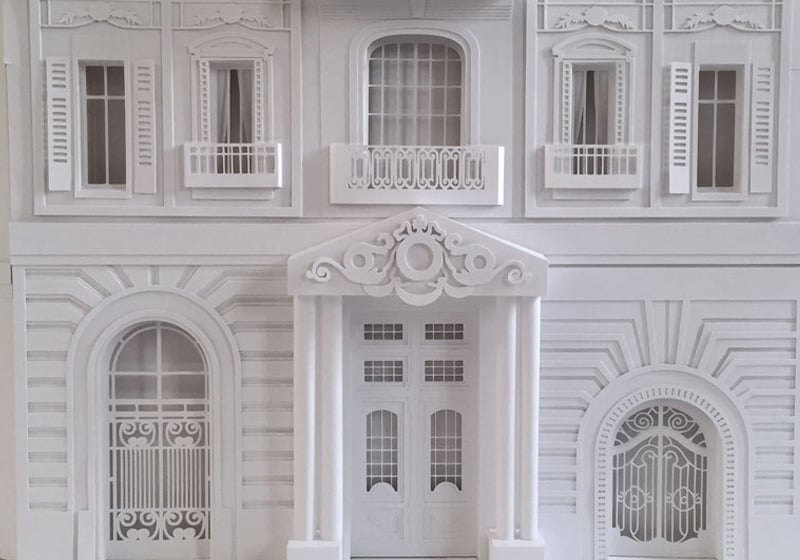Table of Contents
The Spanish artist who creates intricate installations from just paper, reproducing the complex architecture of Paris’s Haussman-style buildings.
Camille Ortoli is a Barcelona-born paper designer who turns simple sheets of white paper into extremely intricate architectural sculptures and installations.
She cuts, folds and glues the paper to create pieces for international clients like Lancôme, Salvatore Ferragamo and L’Oréal, as well as for the window displays of high-end shops. Some of her works are veritable miniature cities, such as her impressive personal project Haussmann, which showcases her talent for paper modelling.

It’s manual work that requires patience, attention to detail and imagination. And Camille Ortoli’s art also shows how she has escaped the screens that most designers remain chained to.
Arrival in Paris and the first pieces
Ortoli moved to Paris to further her artistic career, enrolling in the visual communication course at the prestigious EPSAA art school. During this period, she began to realise that she didn’t want to be stuck in front of a computer all day: she wanted to find something that involved working with her hands.

After a few experiments, she chose paper as the main material through which to express herself artistically. The lightbulb moment came after helping her sister, Solène Ortoli, with a project for the Solab agency that involved making paper decor for videos. Once back at art school, she decided to make art exclusively from paper.
“I was scared at first, because when art school is over, all the teachers advise you to go and work for agencies. But I wanted to show that you could also create interesting work just by cutting pieces of paper”, she said in an interview.

Skill and patience
Camille Ortoli’s tools of the trade are simple and readily available: paper, scissors, glue and craft knives, all of which she uses to create decorations or complex and evocative architectural models: “It’s a job that requires lots patience, which really calms me down while I’m working. What I particularly like about paper is its fragility. You just have to handle it properly: once you’ve understood how to work with it, paradoxically, it becomes much more solid and rigid”, she says.

It all starts with choosing the paper, which she does based on weight. If the decorations she’s working on are small, she often opts for thin paper, which is easier to cut. Paper choice also depends on what the client expects, so it’s sometimes agreed with them beforehand.

Now the creative process begins in earnest: when on a commission, it follows a pre-set procedure. Together with the client, she decides on the theme for the window, event or advertisement. Then Ortoli begins the first drafts, which are cleaned up on Illustrator and sent to the client as two-dimensional models. The next step is to cut and shape the paper. Last of all comes the mise-en-scène with a photographer to capture her creations for posterity, or a film-maker if the work has been commissioned for an advertisement.
Ortoli usually works with just white paper (although from time to time she will use coloured paper too) because she prefers it for creating a certain type of atmosphere.

A paper city
Camille Ortoli often shows her work process on Instagram (which has also brought her major new clients) or on her website. This doesn’t reveal a particular philosophy behind her work, but what it does show are some of her personal projects, including the incredible series of Haussmann buildings.

Evidence of the increasing complexity of her work, it took several years to complete. The buildings are completely “sculpted” from paper: first she created some that were 80 centimetres tall, then she finished the artwork with some that were twice as tall, while maintaining the same level of detail.
The “Haussman style” refers to a specific architectural style used in Paris during the Second Empire. Ortoli wanted to reproduce the smallest details of the facades of these buildings.

As always, she first created 2D buildings on a smaller scale, then she cut and shaped the paper and assembled much bigger models. Each model has the characteristic features of this architectural style: the roofs, modern decorations, the traditional line of windows with small balconies. It takes great paper-cutting skill and meticulous architectural study to create such detailed models.

Camille Ortoli’s talent for creating paper cities and other majestic pieces shows how creativity and dedication can transform a simple material like paper into magnificent pieces of art.
Her passion for and mastery of paper modelling serves as inspiration for other artists to pursue their own visions for hand-crafted artwork. Indeed, art is not just digital and must not simply follow the trends set by social media platforms or algorithms. Artists around the world, such as the astonishing paper artist Yulia Brodskaya, are embarking on a personal journey of discovery, material experimentation and self-expression using paper and other unusual tools and materials.
Guy Laramée is one such example: he uses a sandblaster to shape paper. Camille Ortoli uses “simpler” tools, but the end result is just as complex and compelling.

